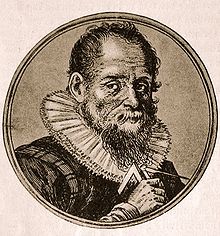Joost Bürgi — Joost Bürgi, or Jobst Bürgi (February 28 1552, Lichtensteig, Switzerland January 31 1632),active primarily at the courts in Kassel, Hesse Kassel (or Hesse Cassel)) and Praha was a Swiss clockmaker, a maker of astronomical instruments and a… … Wikipedia
Joost (name) — Infobox Given Name Revised name = Joost imagesize= caption= pronunciation= gender = Male meaning = region = Dutch origin = related names = footnotes = Joost is a Dutch first name. It derives either from the name Jodocus, which can ultimately be… … Wikipedia
Bürgi — (auch Burgi, Byrgi, latinisiert Byrgius), Joost (Justus), Verfertiger von Himmelsgloben und astronomischen Instrumenten, geb. 28. Febr. 1552 zu Lichtensteig im Kanton St. Gallen, gest. 31. Jan. 1632 in Kassel, war seit 1579 Hofuhrmacher des… … Meyers Großes Konversations-Lexikon
Bürgi, Joost — ▪ Swiss mathematician Joost also spelled Jobst born Feb. 28, 1552, Lichtensteig, Switz. died Jan. 31, 1632, Kassel, Hesse Kassel mathematician who invented logarithms (logarithm) independently of the Scottish mathematician John Napier.… … Universalium
Бюрги — (Joost Bürgi, также Justus Borgen, или Byrgius) один из первых изобретателей часов с маятником. Родился в 1552 г. в Швейцарии; умер в 1632 г. (подробности о нем см. Geschichte der Physik von Poggendörff , стр. 611. См. также История физики… … Энциклопедический словарь Ф.А. Брокгауза и И.А. Ефрона
mathematics — /math euh mat iks/, n. 1. (used with a sing. v.) the systematic treatment of magnitude, relationships between figures and forms, and relations between quantities expressed symbolically. 2. (used with a sing. or pl. v.) mathematical procedures,… … Universalium
Napier, John — born 1550, Merchiston Castle, near Edinburgh, Scot. died April 4, 1617, Merchiston Castle Scottish mathematician and champion of Protestantism. He divided his life between attacks on the church of Rome and the pursuit of numerical calculations.… … Universalium
logarithm — /law geuh ridh euhm, rith , log euh /, n. Math. the exponent of the power to which a base number must be raised to equal a given number; log: 2 is the logarithm of 100 to the base 10 (2 = log10 100). [1605 15; < NL logarithmus < Gk lóg(os) LOG +… … Universalium
Logarithm — The graph of the logarithm to base 2 crosses the x axis (horizontal axis) at 1 and passes through the points with coordinates (2, 1), (4, 2), and (8, 3) … Wikipedia
Prosthaphaeresis — was an algorithm used in the late 16th century and early 17th century for approximate multiplication and division using formulas from trigonometry. For the 25 years preceding the invention of the logarithm in 1614, it was the only known generally … Wikipedia

